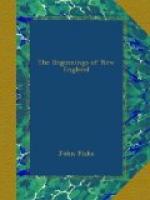Things were becoming desperate. For ten weeks, from September 9 to November 19, the Federal Commissioners were in session daily in Boston. The most eminent of their number, for ability and character, was the younger John Winthrop, who was still governor of Connecticut. Plymouth was represented by its governor, Josiah Winslow, with the younger William Bradford; Massachusetts by William Stoughton, Simon Bradstreet, and Thomas Danforth. These strong men were confronted with a difficult problem. From Batten’s journal, kept during that disastrous summer, we learn the state of feeling of excitement in Boston. The Puritans had by no means got rid of that sense of corporate responsibility which civilized man has inherited from prehistoric ages, and which has been one of the principal causes of religious persecution. This sombre feeling has prompted men to believe that to spare the heretic is to bring down the wrath of God upon the whole community; and now in Boston many people stoutly maintained that God had let loose the savages, with firebrand and tomahawk, to punish the people of New England for ceasing to persecute “false worshippers and especially idolatrous Quakers.” Quaker meetings were accordingly forbidden under penalty of fine and imprisonment. Some harmless Indians were murdered. At Marblehead two were assaulted and killed by a crowd of women. There was a bitter feeling toward the Christian Indians, many of whom had joined their heathen kinsmen in burning and slaying. Daniel Gookin, superintendent of the “praying Indians,” a gentleman of the highest character, was told that it would not be safe to show himself in the streets of Boston. Mrs. Mary Pray, of Providence, wrote a letter recommending the total extermination of the red men.




